Oh, you’ve heard the name International Year of Millets (IYM) and ‘Millets’ (popularly called ‘mota anaj’) many times but don’t know much about it.
In India, before the push for the Green Revolution in the 1960s or during the time of the Indus Valley Civilization.
Most farmers cultivated millet as their staple crop due to the non-availability of irrigation sources. However, due to its low productivity and the availability of irrigation sources like tube wells, networks of canals, farm ponds, etc., farmers switched to other high-productivity crops like paddy.
International Year of Millets: Everything you need to know
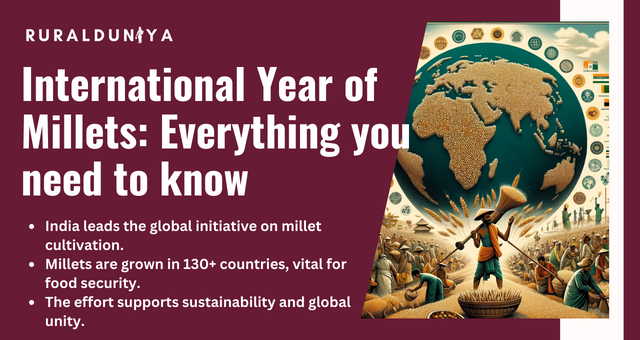
Presently in India, millets are primarily seen as a Kharif crop, requiring less water and inputs compared to other crops. However, they have the capacity to ensure food and nutritional security worldwide, leading to an increase in farmers’ income and making them a potential livelihood activity.
The United Nations General Assembly, during its 75th session in March 2021, declared 2023 as the International Year of Millets (IYM 2023), receiving support from 72 countries. This declaration had earlier been approved by the Food and Agriculture Organization (FAO) in 2018.
These efforts contribute to positioning India as the ‘Global Hub for Millets.’ An interesting fact is that millets are known as ‘Shree Anna’ due to their cultural and traditional significance.
Nowadays, millets are grown in more than 130 countries and are considered traditional food among more than half a billion people in Africa and Asia. Additionally, IYM also aligns with the 2030 Agenda for Sustainable Development.
Objectives of Celebrating the International Year of Millets 2023
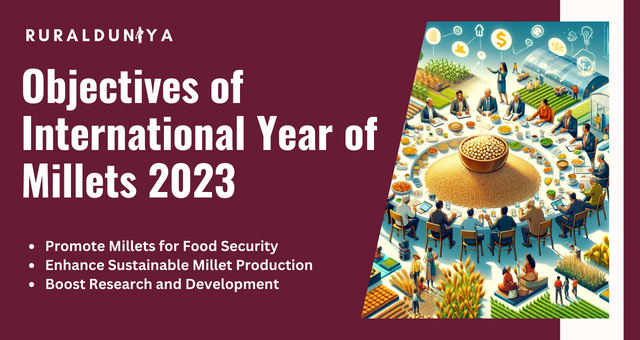
- Creating awareness on the use of millets in Food Security and Nutrition.
- Inspiring stakeholders to improve the sustainable production and quality of millets.
- Pooling investments to accelerate research and development, as well as extension services, to achieve the other two goals.
What are Millets?
Over the last few years, the healthy food market has evolved, leading to an increased demand for millets. Millet, being a low-maintenance and drought-resistant grain, also offers numerous health benefits, ranging from weight loss to addressing heart issues.
Millets are cereal crops, and for ages, they have been used as fodder for animals and as a staple food for humans. They are round in shape.
History of Millets in India
Millets are ancient grains that have been around for a long time. They are small, sturdy plants that can grow in conditions where other crops fail, such as drought or bad soil.
They grow in the following states: Haryana, Uttar Pradesh, Chhattisgarh, Gujarat, Rajasthan, Madhya Pradesh, Maharashtra, Andhra Pradesh, Karnataka, Tamil Nadu, and Telangana.
Millets have an intriguing feature: they grow quickly. They may go from seed to completely mature harvest in around 65 days! This is especially important in areas where a large number of people live and need food quickly.
Millets also have the advantage of being able to last for so many years if stored properly.
Millets are not only hardy plants, but they also provide good nourishment for both humans and animals. They may be grown with other crops, independent of water availability.
Because they develop quickly, they are ideal for agricultural systems in which farmers grow numerous crops at the same time.
What are the Millets Available in India?
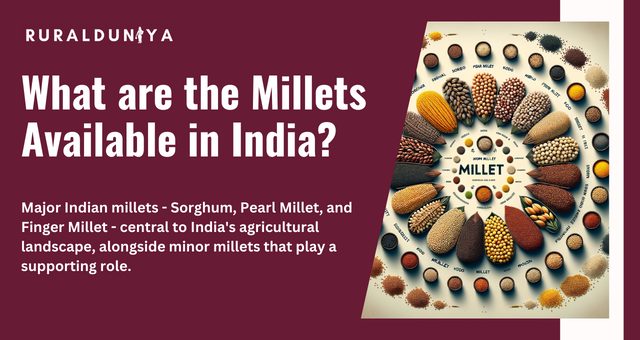
There are various types of millets with different shapes and sizes that we can explore below –
- Sorghum Millet (Jowar)
- Proso Millet (Chena / Barri)
- Pearl Millet (Bajra)
- Foxtail Millet (Kakum / Kangni)
- Finger Millet (Ragi)
- Browntop Millet (Korle)
- Barnyard Millet (Sanwa)
- Little Millet (Moraiyo)
- Buckwheat Millet (Kuttu)
- Amaranth Millet (Rajgira)
- Kodo Millet
But in the Indian scenario, out of these millets, the major ones are sorghum, pearl millet, and finger millet, while the minor millets include foxtail, little millet, kodo, proso, and barnyard millet.
Initiatives of Government for Millet Awareness
In the last few years, the government has taken various steps to promote millets at the national and international levels. Let’s discuss some of the major initiatives:
- In 2007, the Government of India launched the National Millets Mission (NMM) to promote the production and consumption of millets.
- The formation of Farmer Producer Organizations (FPOs), setting up Centers of Excellence (CoE), and seed hubs for Shree Anna was initiated.
- The Indian Institute of Millets Research (IIMR) in Hyderabad has been declared the Centre of Excellence for research and technologies on it at the national and international levels.
- They were introduced by the Ministry of Women and Child Development in the Poshan Mission Abhiyan.
- The Government of India and many State Governments have set the Minimum Support Price (MSP) for millets to increase their production.
- The government has initiated the introduction of millets in the Public Distribution System (PDS) to make them accessible and affordable to the masses.
Health Benefits of Millets
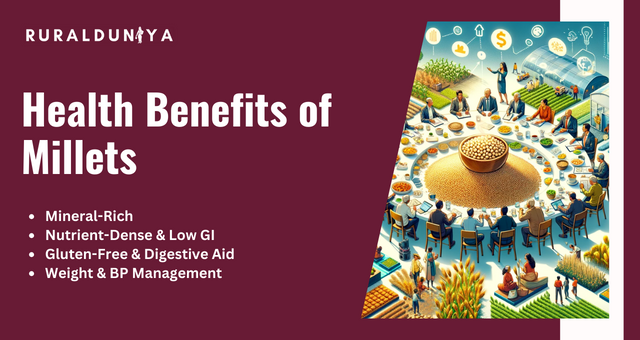
There are various health benefits of millets. Let’s discuss them one by one –
- Millets are a good source of minerals like iron, zinc, and calcium.
- Millets are very helpful in reducing weight, BMI, and high blood pressure.
- In comparison to wheat and maize, millets are high in nutrients and have a low glycemic index of 54-68.
- They are gluten-free and can be consumed by celiac disease patients.
- As millets are rich in fiber sources, they benefit digestion by alleviating bloating, gas, and constipation.
Facts About Millets in India
Millets are tiny, nutrient-packed foods that support a nutritional and health-friendly diet. Let’s explore its top 5 interesting facts –
- Sorghum is a health-promoting, nutritious crop.
- Millet is packed with essential nutrients like fiber, protein, B vitamins, calcium, magnesium, iron, and zinc.
- Cultivation of barley helps in reducing the carbon footprint.
- Amaranth provides nutritional security and protects against nutritional deficiencies in children and women.
- Buckwheat is a gluten-free crop.
- Millet alternatives can be used as a rice substitute.
- Millet oats can be included during the weight loss journey.
- Ragi has a long shelf life.
Why are Millets Important in UPSC exam?
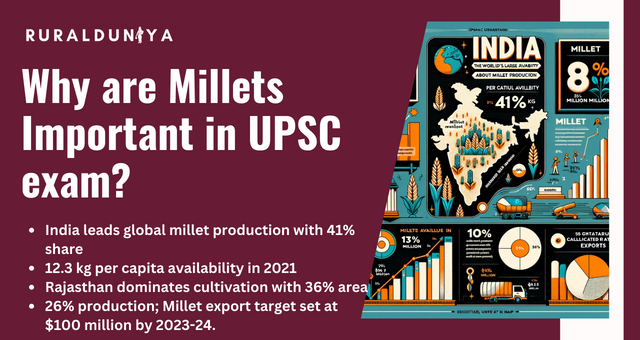
There are various interesting things about millets, out of which a few are particularly interesting to cover in UPSC preparation –
- As of 2021, India is the largest producer of millets, with a total share of 41%.
- The per capita availability of millets in 2021 was approximately 12.3 kg.
- Rajasthan contributed to 36% of the total area for millet cultivation and production, accounting for 26% in India.
- APEDA has set a target of $100 million for millet exports by 2023-24, up from $64.28 million in 2021-22.
Final Words
From all this, we can conclude that the International Year of Millets can help fight global hunger, malnutrition, and promote sustainable agriculture. It can also assist farmers in arid and semi-arid regions worldwide.
With the intervention of governments, private organizations, and CSOs, the connection between the market and agricultural produce strengthens.
This has a positive impact not only on hunger, climate change, and malnutrition but also on the income of small and marginal farmers worldwide, boosting the local economy.
FAQs
Who declared 2023 as a Millet year?
United Nations General Assembly at its 75th session declared 2023 as International Year of Millets.
Who is the Millet Man of India?
The Millet Man of India is Dr. Khader Vali.
Who is the first largest exporter of millets in the world 2023?
In 2023, Ukraine emerged as the world’s leading exporter of millets.
What is the theme of the International Year of Millets 2023?
The theme of the International Year of Millets is “Healthy Millets, Healthy People.”
Which important Millets are grown in India?
Jowar (sorghum), Bajra (pearl millet), ragi (finger millet), Jhangora (barnyard millet), Barri (Proso or common millet), Kangni (foxtail/Italian millet), and Kodra (Kodo millet) are some of the millets that are widely grown in India.

Nishank is a social impact enthusiast with a solid foundation in public policy, micro-enterprise, and agribusiness. Growing up in a farmer’s family has given him a profound connection to rural communities, fueling his passion to empower people towards self-reliance. He completed his undergraduate studies at the Delhi University and earned a master’s degree in Rural Management from National Institute of Rural Development & Panchayati Raj in Hyderabad.



